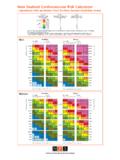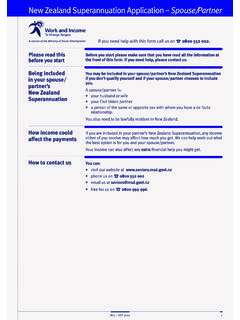Transcription of NEW ZEALAND - OECD.org
1 SCIENCE AND INNOVATION: NEW ZEALANDOECD SCIENCE, TECHNOLOGY AND INDUSTRY OUTLOOK 2012 OECD 2012352 NEW ZEALANDG eneral features of the STI system: In spite of asignificant reform effort, New ZEALAND s long-runproductivity performance has been disappointing. Itseconomic geography a small market in a peripherallocation creates challenges. Its economic structurerelies heavily on its primary industries and it lackslarge firms. This limits the level and leverage effectsof business R&D investments throughout the broaderSTI system. BERD intensity is low at just of GDPin 2009 (Panel 1(d)). Yet the innovation system hassome strengths. The comparatively high share ofpublic research funded by industry indicates soundlinkages (1(o)).
2 The country s RTA in bio- and nano-technologies has recently risen strongly and it hasremained rather stable in ICTs and environment-related technologies (Panel 3). Educationalattainment and skill levels are strong. PISA scores inscience for 15-year-olds are the second highest in theOECD (1(t)). Some 40% of the adult population aretertiary-qualified (1(s)), 30% persons employed are inS&T occupations (1(v)) and there are researchersper thousand total employment. Researchers arereasonably well integrated into global networks: 50%of scientific articles and 20% of PCT patentapplications were produced with internationalcollaboration (1(q)(r)). ICT infrastructures are welldeveloped. The number of fixed broadband andwireless subscribers is now a comparably high 26 and54 per 100 inhabitants, respectively (1(k)(l)), and the e-government readiness index is above the OECD median (1(n)).
3 Recent changes in STI expenditures: GERD is relativelylow at of GDP but grew by between 2005and 2009. In 2009, industry funded 38% of GERD,government funded 54% and 5% was funded fromabroad. Funding was made available for nationalscience challenges to boost fundamental innovation solutions. The new Ministry of Scienceand Innovation (MSI) is promoting the redevelopmentof Christchurch, which has a number of high-technology firms, as a high-technology city and hasmade significant investments in the Natural STI strategy: The MSI Statement ofIntent 2011-14 reflects a shift in strategy. Ithighlights two high-level outcomes growing theeconomy and building a healthier environment andsociety and remains committed to innovation intraditional resource sectors.
4 However, it intends toadd new areas of capability in knowledge-intensiveactivities, such as high-technology manufacturingand the services sector. It identifies six priorityareas: high-value manufacturing and services,biological sciences, energy and minerals, hazardsand infrastructure, the environment, and healthand policy governance: MSI was created in 2010 andassumed responsibility for the Crown ResearchInstitutes (CRIs) in close co-operation with the RoyalSociety of New ZEALAND . In line with the OECD Reviewof Innovation Policy: New ZEALAND (2007) and a review ofHot STI issues Providing long-term goals and clear governance of the innovation system. Developing and growing knowledge-intensive businesses.
5 Further strengthening the internationalisation of the innovation system. Rebuilding Christchurch as a high-technology figuresLabour productivity, GDP per hour worked in USD, , as % of GDP, (annual growth rate, 2005-10 )(+ ) (annual growth rate, 2005-09)(+ )Environmental productivity, GDP per unit of CO2 emitted in USD, publicly financed, as % of GDP, (annual growth rate, 2005-09)(+ ) (annual growth rate, 2005-09)(+ ) SCIENCE AND INNOVATION: NEW ZEALANDOECD SCIENCE, TECHNOLOGY AND INDUSTRY OUTLOOK 2012 OECD 2012353 Figure and innovation in New ZealandNote:Normalised index of performance relative to the median values in the OECD area (Index median = 100).050100150200100020015050 Public R&D expenditure (per GDP) (a) Top 500 universities (per GDP) (b) Publications in the top-quartile journals (per GDP) (c)Fixed broadband suscribers (per population) (k) Wireless broadband suscribers (per population) (l) Networks (autonomous systems) (per population) (m) E-government readiness index (n) Industry-financed public R&D expenditures (per GDP) (o) Patents filed by universities and public labs (per GDP) (p) International co-authorship (%) (q) International co-patenting (%) (r) Adult population at tertiary education level (%) (s) 15-year-old top performers in science (%) (t) Doctoral graduation rate in science and engineering (u) S&T occupations in total employment (%) (v)
6 Business R&D expenditure (per GDP) (d) Top 500 corporate R&D investors (per GDP) (e) Triadic patent families (per GDP) (f) Trademarks (per GDP) (g) Venture capital (per GDP) (h) Patenting firms less than 5 years old (per GDP) (i) Ease of entrepreneurship index (j)Top halfOECD Bottom halfOECD Science baseBusiness R&D and innovationEntrepreneurshipPanel 1. Comparative performance of national science and innovation systems, 2011a. Competences and capacity to innovateTop/bottom 5 OECD valuesMiddle range of OECD valuesOECD medianNew Zealandb. Interactions and human resources for innovationKnowledge flows andcommercialisation Internet for innovationHuman resourcesTop halfOECD Bottom halfOECD SCIENCE AND INNOVATION: NEW ZEALANDOECD SCIENCE, TECHNOLOGY AND INDUSTRY OUTLOOK 2012 OECD 2012354the eight CRIs, reforms were introduced in 2011 tochange their focus from profitability towardsgrowth in the sectors they are linked with.
7 Thisfive-year funding agreement included shiftingUSD 155 million from contestable funding tocore funding to increase the focus on researchcollaboration and technology transfer. Policyevaluation tends to be impact-oriented and willbecome smaller and quicker in the next decade,with a focus on pilot policy programmes. Science base: New ZEALAND has a dual sciencesystem based on universities and the CRIs. Thesystem is strong, as reflected in public expenditureon R&D, highly ranked universities and its researchpublication record (1(a)(b)(c)). Public R&Dexpenditure was of GDP in 2009, but with therestructuring of CRIs, funding for health, state-owned and business-related research will R&D and innovation: Although BERD iscomparatively low, New ZEALAND reversed its R&Dtax credit in 2010.
8 MSI currently offers four R&Dsupport schemes: technology transfer vouchers,technology development grants, capability fundingand funding from the New ZEALAND VentureInvestment Fund (NZVIF). Entrepreneurship: New ZEALAND s venture capitalindustry is relatively immature. The NZVIF hashowever made an impact, and invests USD 132million through the Venture Capital Fund of Fundsand the Seed Co-investment Fund. The IncubatorSupport programme facilitates the growth of early-stage businesses. ICTs and scientific infrastructures: In view of NewZealand s geography, a high-performing ICTinfrastructure is critical. To build on its current ICTcapacity, the government will invest nearlyUSD 20 million over the next four years in theNational e-Science Infrastructure (NeSI), a network ofsupercomputers, software and data will use the Kiwi Advanced Research andEducation Network (Karen), which offers very highcapacity broadband.
9 MSI has also developed anInnovation Entrepreneurship Programme to supportentrepreneurs in digital technologies. Ultra-fastBroadband in Schools (UFBiS) is a secondary schoolprogramme. Knowledge flows and commercialisation: A NationalNetwork of Commercialisation Centres (NNCC) is tobe in place in 2012, linking research organisations,entrepreneurs, incubators and regionaldevelopment agencies. To ensure that theintellectual property regime remains in line withinternational standards, a new Patents Bill iscurrently under debate. Subject to commercialsensitivity, research findings are required to bepublished in journals and publicly availabledatabases. This will increase the flow of publiclyfunded research to the general public, throughplatforms such as the Kiwi Research InformationService and : New ZEALAND has strong internationalnetworks, in spite of its remote location.
10 GlobalExpert, a network of experts from universities,research institutions and global companies, assistsfirms to identify scientific, technological and marketopportunities. New ZEALAND Trade and Enterprise(NZTE) and Beachheads Advisor Networks also linkhigh-growth businesses with international international PhD students to pay domestictuition fees has increased interest from resources: To build on its already high level ofhuman capital, a Science Programme was launchedto raise student achievement in schools; the TertiaryEducation Strategy 2010-15 outlines the vision forhigher education. The Marsden Fund andRutherford Discovery Fellowships fund exceptionalresearch and support the career development oftalented researchers.
















